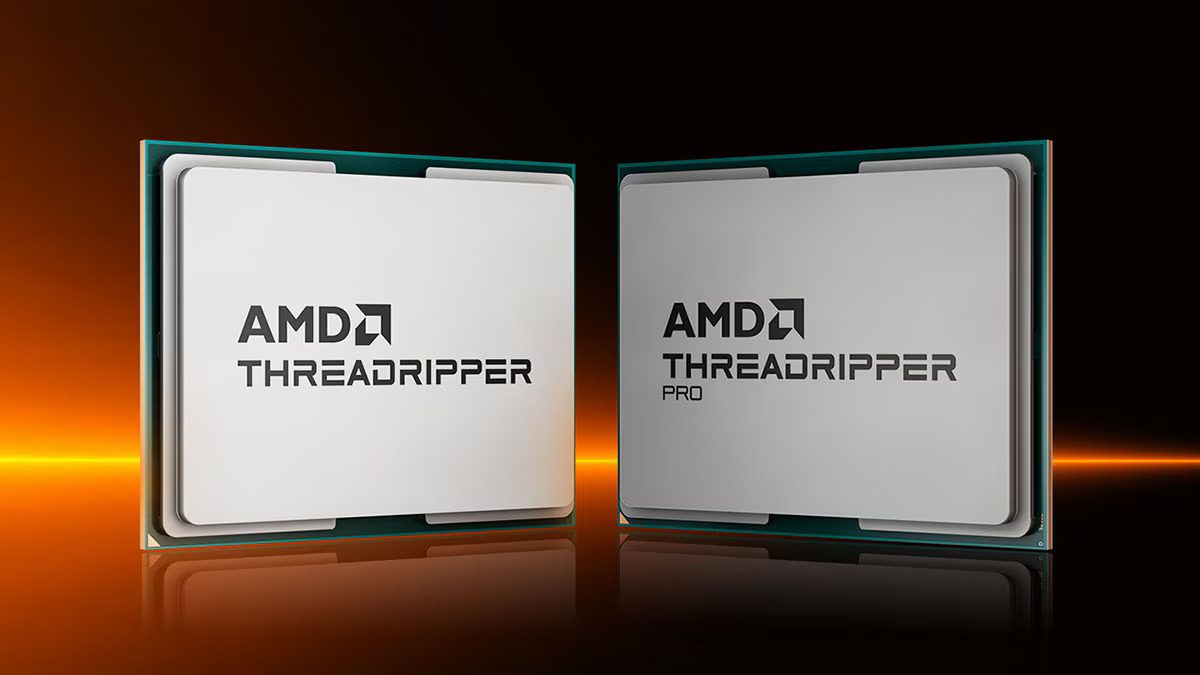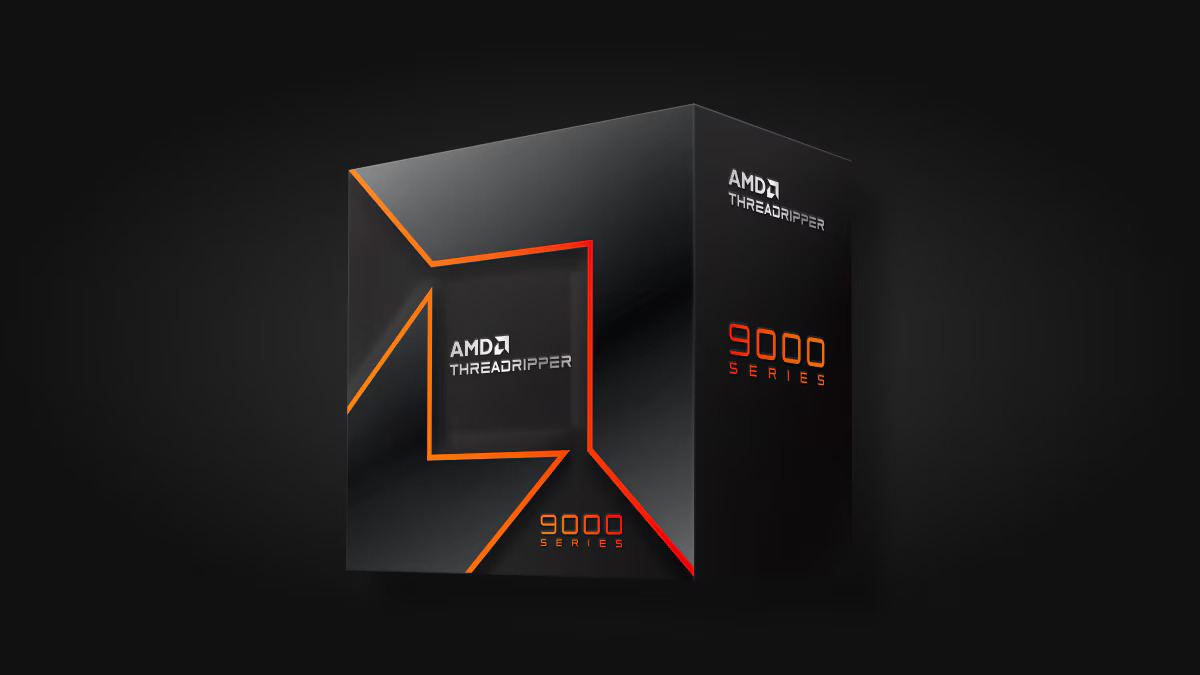The AMD Threadripper 9000 series brings HEDT and workstation computing back into focus. Built on the Zen 5 architecture, these CPUs deliver extraordinary multi-thread performance, cutting-edge platform features, and the bandwidth modern creative and AI workloads demand.
Next-Gen Zen 5 Architecture
Threadripper 9000 CPUs use AMD’s 4 nm Zen 5 design, offering higher IPC and improved power efficiency. Depending on the model, users can access up to 96 cores and 192 threads, making them ideal for rendering, simulation, code compilation, or local AI workloads.

Two Platforms: TRX50 vs WRX90
TRX50 (sTR5 socket) targets high-end desktop and prosumer creators. It supports quad-channel DDR5 memory and up to 80 PCIe 5.0 lanes, perfect for multi-GPU and NVMe RAID setups.
WRX90 (sWRX9 socket) powers the Threadripper Pro 9000WX series. It doubles memory channels to eight, adds ECC DDR5 support, and expands connectivity to 128 PCIe 5.0 lanes, delivering true workstation bandwidth for engineers, AI developers, and VFX professionals.
In 3D rendering, video editing, and software compilation, Threadripper 9000 cuts render and build times dramatically. Studios using CPU renderers such as Arnold or V-Ray can see near-linear scaling up to 96 cores. AI developers also benefit from vast I/O and memory bandwidth for data preprocessing and multi-GPU inference pipelines.
While mainstream Ryzen processors are still excellent for gaming, the Threadripper 9000 excels in parallel compute workloads where every core counts.
Platform Highlights
-
Memory: DDR5 6400 MT/s (TRX50), octa-channel ECC DDR5 (WRX90)
-
PCIe 5.0 lanes: 80 (HEDT) / 128 (Pro WX)
-
TDP: ≈ 350 W — requires high-end cooling
-
Overclocking: Supported; robust VRM motherboards recommended
For builders, the platform provides freedom to design extreme systems — multi-GPU AI rigs, ultra-fast NVMe RAID arrays, or heavy compute nodes.
Cooling and Power Recommendations
Due to its 350 W power envelope, Threadripper 9000 requires a 360 mm AIO or custom water loop. Combine that with a 1000 W+ PSU for single-GPU systems, or 1600 W+ for multi-GPU workstations. Proper airflow and BIOS tuning ensure stable sustained boosts during long renders.
AMD’s Threadripper 9000 series marks the company’s return to high-end desktop (HEDT) and workstation dominance with Zen 5 microarchitecture, massive core counts, and platform improvements aimed squarely at creators, engineers, and AI developers. Whether you’re rendering photoreal scenes, compiling enormous codebases, training or fine-tuning models, or driving multi-GPU workstations, Threadripper 9000 offers a platform designed to remove bottlenecks and accelerate real-world workflows. Below is a complete, SEO-friendly deep dive into what the 9000 series brings, how it compares to alternatives, and practical guidance for buying and building around it.
What is the Threadripper 9000 series?
The Threadripper 9000 family is AMD’s latest lineup of HEDT and workstation processors based on the Zen 5 core, spanning both consumer HEDT Threadripper SKUs and the higher-capability Threadripper Pro WX workstation SKUs. The HEDT family targets high-end desktop users (TRX50 platform) with up to 64 cores/128 threads, while the Pro WX family scales even higher — up to 96 cores/192 threads — with more memory channels and increased PCIe lanes for dense GPU and storage configurations. These CPUs are built to tackle massive multi-threaded workloads and heavy I/O demands.

Key headline specs (what matters most)
-
Microarchitecture: Zen 5 (4nm process) — higher IPC and efficiency than prior Zen generations.
-
Core counts: HEDT Threadripper models up to 64 cores / 128 threads; Threadripper Pro WX models up to 96 cores / 192 threads.
-
Memory: HEDT TRX50: quad-channel DDR5 (up to DDR5-6400); Pro WRX90: octa-channel DDR5 ECC on Pro WX parts (greater capacity and bandwidth for datasets and large scenes).
-
PCIe: Up to 80 PCIe 5.0 lanes on HEDT models (optimized for multi-GPU + NVMe), and up to 128 PCIe 5.0 lanes on Pro variants for very dense I/O.
-
Power envelope: Typical package TDP around 350 W — high power, so plan cooling and VRM accordingly.
These headline numbers underline AMD’s positioning: raw parallel compute plus platform bandwidth rather than incremental single-thread cache tweaks.
Platform breakdown — TRX50 vs WRX90
Understanding which platform you need is critical:
-
TRX50 (sTR5 socket) — Targets HEDT builders and creators. Typically offers quad-channel DDR5, up to 80 PCIe 5.0 lanes, and works with consumer-class workstation motherboards geared for prosumers who still want a powerful desktop experience. Best for creators who need high core counts combined with workstation-level I/O without stepping fully into enterprise pricing.
-
WRX90 (sWRX9 socket) — Threadripper Pro WX — Enterprise/workstation platform: octa-channel DDR5 ECC, more PCIe lanes (up to 128), and higher memory capacity limits. Ideal for VFX studios, simulation engineers, and AI teams who need the absolute maximum memory bandwidth and I/O density. Pro WX models are often sold through OEM workstation channels.
Real-world performance — where Threadripper 9000 shines
Threadripper’s strengths show up in workloads that can parallelize:
-
3D rendering and ray tracing — CPU-bound renderers (e.g., CPU V-Ray, Arnold) scale almost linearly with core count; the 64- and 96-core options dramatically cut render times. Review benchmarks and studio tests show large multi-core lead over mainstream desktop CPUs and strong competitiveness versus Intel’s server/workstation parts in multi-threaded rendering.
-
Video encoding & transcoding — When multiple high-bitrate timelines or simultaneous encodes are required, extra cores provide clear throughput advantages. Note: GPU acceleration still matters for many codecs, but CPUs determine how many concurrent streams you can process without GPU saturation.
-
Compiling large codebases — More cores shorten full-build times for huge projects or when parallel compilation is used.
-
Local AI model fine-tuning & inference — The Pro WX variants, with their memory capacity and PCIe lanes, are particularly useful for inference pipelines and multi-GPU model training or finetuning where fast CPU pre/post-processing and I/O are crucial. AMD highlights Threadripper 9000’s suitability for AI development.
Benchmarks from independent labs show that while single-thread performance is competitive, the real advantage is throughput on highly parallel tasks. For workloads limited by GPU compute or by single-thread latency, the uplift will be smaller.
Power, thermals and cooling — plan for it
A 350 W TDP and the thermal density of up to 64 or 96 cores mean cooling and power delivery are not optional details — they’re companions in any build:
-
Cooling: High-end AIO liquid coolers (360 mm) or custom-loop water cooling is recommended for consistent sustained boost; extreme overclocking has already been seen with LN2 in labs. Also ensure case airflow supports heat rejection from radiators.
-
Motherboard VRMs: Look for professional-grade VRM designs with robust phases and heatsinks. Pro-class motherboards for WRX90 often include heavier-duty VRMs by default.
-
Power supply: Large builds with multiple GPUs plus a 350 W CPU demand high wattage PSUs (1000 W+ depending on GPU count). Factor in headroom for peak power draw and overclocking.
Comparing Threadripper 9000 to alternatives
-
vs mainstream desktop Ryzen (e.g., Ryzen 9 desktop parts): Threadripper scales to far higher core counts, wider memory channels, and far more PCIe lanes. For single-thread workflows, a Ryzen desktop CPU may be more cost-efficient, but for heavy multi-threaded throughput the Threadripper wins.
-
vs Intel workstation/server parts: AMD’s 96-core Pro flagship competes directly with high-core-count Intel Xeon W and server SKUs. In many multi-threaded benchmarks AMD often leads on price-to-performance and memory bandwidth, although Intel sometimes posts similar results in specific workloads. For creators and studios balancing cost vs performance, Threadripper Pro’s core/memory balance is compelling. Independent reviews and AMD’s own comparisons highlight strong multi-thread leadership.
Who should buy a Threadripper 9000?
-
Studios and professional content creators needing dramatic cuts in render farms or local render times.
-
Engineers and simulation teams that rely on high memory bandwidth and massive parallel compute.
-
AI developers who run local fine-tuning, inference, or multi-GPU workstation tasks requiring high CPU-driven I/O throughput.
-
Enthusiasts building extreme workstations where single-system concurrency (many VMs, many encode streams, massive local storage arrays) is required.
If your primary tasks are gaming, single-threaded applications, or a limited number of GPU-accelerated creative workloads, a high-end desktop Ryzen 9 or mainstream HEDT part may provide better value.
Build and configuration tips
-
Choose platform with future needs in mind: If you expect to expand to many GPUs or need ECC and massive RAM, invest in WRX90 and Pro WX. If you’re a creator who needs high cores but don’t need ECC or octa-channel RAM, TRX50 can be more cost-effective.
-
Prioritize cooling and case airflow: Use at least a 360 mm AIO or custom loop for sustained workloads. Overprovision fan curves for long render sessions.
-
Memory speed vs capacity: Balance DDR5 speed and capacity by workload — for many pro workflows, capacity and channel count matter more than pushing the highest clock rates. Pro WX’s ECC DDR5 and octa-channel layout is optimized for this.
-
PSU margin: Size your PSU for worst-case: CPU + peak GPU draw + 20–25% headroom. Multi-GPU workstation builders should budget 1600 W+ depending on cards.
-
BIOS and driver updates: Since Threadripper 9000 is a new platform generation, keep motherboard BIOS and chipset drivers updated for stability and performance fixes post-launch. AMD and vendors are actively releasing microcode and firmware updates.
| Feature | AMD Threadripper 9000 | Intel Xeon W9-3495X | AMD Ryzen 9 9950X |
|---|---|---|---|
| Architecture | Zen 5 (4 nm) | Sapphire Rapids (10 nm) | Zen 5 (4 nm) |
| Max Cores / Threads | 96 / 192 (Pro WX) | 56 / 112 | 16 / 32 |
| Memory Channels | 4 (HEDT) / 8 (Pro) | 8 | 2 |
| PCIe 5.0 Lanes | 80 / 128 | 112 | 24 |
| TDP | ≈ 350 W | ≈ 350 W | 170 W |
| Target Users | Creators, engineers, AI devs | Enterprise workstations | Gamers & prosumer creators |
Pricing and Availability
AMD launched the Threadripper 9000 series in mid-2025, with HEDT models starting around $1,499, and the top-end Pro WX 96-core versions surpassing $10,000 in enterprise channels. Expect full platform bundles with high-end TRX50/WRX90 motherboards and premium DDR5 kits.
For professionals whose workflows scale with cores, memory bandwidth, and I/O — absolutely. AMD has positioned the Threadripper 9000 family to outperform prior HEDT generations and to challenge server-class options in the workstation space. The platform is not for every user, but for those who need it, Threadripper 9000 removes many architectural bottlenecks that used to constrain creative and engineering workloads. If you’re building a workstation for heavy multi-threaded tasks, local AI development, or a multi-GPU render machine, Threadripper 9000 belongs at the top of your shortlist.

